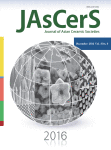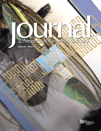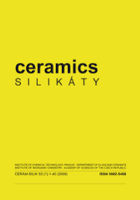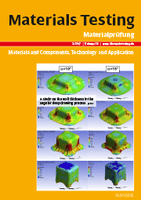
International Journal of Applied Ceramic Technology
Scope & Guideline
Transforming materials science with cutting-edge findings.
Introduction
Aims and Scopes
- Advanced Ceramic Materials:
Research on novel ceramic materials, including high-temperature ceramics, piezoelectric, and ferroelectric ceramics, emphasizing their synthesis, microstructure, and properties. - Ceramic Processing Techniques:
Investigation of various processing methods such as additive manufacturing, sol-gel techniques, and spark plasma sintering aimed at optimizing the mechanical and thermal properties of ceramics. - Ceramic Coatings and Composites:
Development and characterization of ceramic coatings for enhanced performance in applications like wear resistance, corrosion protection, and thermal barrier coatings. - Bioceramics and Biomedical Applications:
Exploration of bioceramic materials for medical applications, including drug delivery systems and bone regeneration, focusing on biocompatibility and mechanical properties. - Environmental and Sustainable Ceramics:
Research on ceramics derived from waste materials and their applications in pollution control, energy saving, and sustainable manufacturing practices. - Characterization Techniques:
Application of advanced characterization methods such as X-ray diffraction, scanning electron microscopy, and mechanical testing to understand the properties and behaviors of ceramic materials.
Trending and Emerging
- Additive Manufacturing and 3D Printing of Ceramics:
An increasing number of studies focus on the application of additive manufacturing techniques, highlighting the potential for creating complex geometries and customized ceramic components. - Nano-Structured and High-Entropy Ceramics:
Research into nanostructured ceramics and high-entropy ceramics is emerging, emphasizing their unique properties for applications in electronics and energy storage. - Sustainable and Green Ceramics:
There is a growing emphasis on the development of sustainable ceramics, including the use of recycled materials and environmentally friendly manufacturing processes. - Functional Ceramics for Energy Applications:
Emerging research focuses on ceramics for energy applications, including solid oxide fuel cells and thermoelectric materials, reflecting a trend towards energy-efficient technologies. - Bioceramics and Biomaterials:
A significant increase in studies related to bioceramics for medical applications, particularly in bone regeneration and dental materials, highlighting their importance in healthcare. - Electrochemical and Photocatalytic Properties:
Research related to the electrochemical properties of ceramics, particularly for energy storage and photocatalytic applications, is gaining momentum as industries seek efficient materials.
Declining or Waning
- Traditional Ceramic Applications:
Research related to conventional ceramics for household and aesthetic purposes has decreased, as the focus shifts towards advanced materials with specific functional properties. - Low-Temperature Processing Techniques:
There is a noticeable reduction in studies focused on low-temperature processing methods, as the trend moves towards high-performance materials that often require elevated processing temperatures. - Refractory Materials for Conventional Industries:
Research on refractory materials specifically for traditional industries such as steelmaking is waning, likely due to a growing interest in innovative materials and processes. - Static Load Testing Methods:
Static load testing methods are being replaced by dynamic testing approaches, with fewer publications focusing on traditional static methodologies for ceramic evaluation.
Similar Journals

JOURNAL OF MATERIALS PROCESSING TECHNOLOGY
Pioneering Research in Materials Processing ExcellenceJOURNAL OF MATERIALS PROCESSING TECHNOLOGY, published by ELSEVIER SCIENCE SA, is a premier international journal dedicated to the dissemination of cutting-edge research in the field of materials processing. With an impact factor indicative of its high academic quality, this journal features a diverse range of topics, including ceramics, composites, metals, and manufacturing technologies, thereby inspiring innovations within its community. As a recognized Q1 journal across multiple categories—including Ceramics and Composites, Computer Science Applications, Industrial and Manufacturing Engineering, and Modeling and Simulation— it ranks among the top in its field. The journal's rigorous peer-review process ensures the publication of only the most significant and relevant studies, supporting researchers, professionals, and students in advancing their knowledge and expertise. With its commitment to excellence, the JOURNAL OF MATERIALS PROCESSING TECHNOLOGY remains a vital resource for those aiming to push the boundaries of materials science and engineering.

Journal of Asian Ceramic Societies
Advancing ceramic innovation across Asia.The Journal of Asian Ceramic Societies, published by Taylor & Francis Ltd, is a peer-reviewed open-access journal that has been at the forefront of ceramic research since its inception in 2013. With an ISSN of 2187-0764, this esteemed journal is dedicated to advancing the scientific understanding of ceramics and composites, bolstered by an impressive ranking of Q2 in the field of Materials Science. Covering a wide range of topics pertinent to ceramics, the journal aims to foster collaboration among researchers, professionals, and students across Asia and beyond. Its commitment to accessibility allows a global audience to engage with cutting-edge research, reflected in its Scopus ranking of #45 out of 127 in the Materials Science category. With a publication timeline extending to 2024, the Journal of Asian Ceramic Societies is an indispensable resource for anyone looking to stay informed on the latest developments and innovations in ceramic technology.

JOURNAL OF THE AMERICAN CERAMIC SOCIETY
Advancing the Frontiers of Ceramics ResearchJOURNAL OF THE AMERICAN CERAMIC SOCIETY, a prestigious publication within the field of ceramics and materials science, has been at the forefront of advancing research since its inception in 1918 and will continue to be a leading resource through 2024. Published by WILEY, this journal boasts an impressive impact factor, reflecting its strong reputation in the academic community. With its categorization in the Q1 quartile for both Ceramics and Composites and Materials Chemistry, the journal is ranked among the top in its fields, placing it in the 78th and 76th percentiles, respectively, according to Scopus metrics. Although not an open-access journal, it provides critical insights, robust research findings, and a platform for experts to disseminate their work, making it an essential resource for researchers, professionals, and students alike who are engaged in ceramic sciences and materials innovation. The Journal’s meticulous peer-review process ensures the highest quality and relevance of publications, fostering a rich environment for academic discourse and collaboration.

INTERNATIONAL JOURNAL OF REFRACTORY METALS & HARD MATERIALS
Leading the way in high-impact materials research.INTERNATIONAL JOURNAL OF REFRACTORY METALS & HARD MATERIALS, an esteemed publication by Elsevier Science Ltd, stands at the forefront of materials research, focusing on the development and application of refractory metals and hard materials in various engineering fields. With an impressive impact factor and recognition as a Q1 journal across several categories including Ceramics and Composites, Materials Chemistry, and Mechanical Engineering, it serves as a vital resource for researchers, professionals, and students alike. The journal has been continuously publishing high-quality research since its inception in 1982, with a convergence of developments spanning through to 2024. Its Scopus rankings further emphasize its significance, boasting ranks in the top percentiles of relevant scientific fields. Although it operates under a subscription model, the depth and rigor of the research published within its pages ensures that it remains an invaluable tool for those pursuing innovation and exploration in materials science.

Journal of the Korean Ceramic Society
Unveiling the potential of ceramics in modern applications.The Journal of the Korean Ceramic Society is a premier academic journal dedicated to advancing the field of ceramics and composites, serving as a vital platform for researchers, professionals, and students alike. Published by SPRINGER HEIDELBERG, this journal boasts an impressive scopus rank of #49 out of 127 in the Materials Science category, with a commendable 61st percentile ranking, highlighting its impact and relevance in contemporary research. Since its inception, the journal has been converging significant research contributions from 2007 to 2024, consistently fostering innovation in ceramic materials and their diverse applications. Although it operates under a traditional access model, the journal remains committed to disseminating high-quality research in ceramics and composites, currently positioned in the Q2 category for 2023. With a strategic focus on the latest developments, methodologies, and interdisciplinary approaches, the Journal of the Korean Ceramic Society is essential reading for anyone engaged in materials science and engineering, aiming to navigate the complexities of this dynamic field.

CERAMICS-SILIKATY
Exploring the Boundaries of Ceramics ResearchCERAMICS-SILIKATY is a distinguished open-access journal published by the University of Chemistry and Technology, Prague, specializing in the fields of Ceramics and Composites, Analytical Chemistry, Chemical Engineering, and Materials Chemistry. Since its inception in 1991, this journal has played a pivotal role in disseminating cutting-edge research and innovative findings in the study of ceramics, emphasizing both fundamental and applied aspects. With a commitment to accessibility since 2000, CERAMICS-SILIKATY promotes knowledge sharing among researchers, professionals, and students globally. The journal's current standing in the Q3 Quartile across several categories highlights its significant contributions and relevance in the academic community. As a hub for interdisciplinary research, the journal invites submissions that advanced our understanding of ceramic materials and their applications, positioning itself as an essential resource for those engaged in the forefront of materials science.

Transactions of the Indian Ceramic Society
Unveiling Insights in Ceramic ScienceTransactions of the Indian Ceramic Society is a distinguished journal published by Taylor & Francis Ltd, focusing on the vital field of ceramics and composites. With an ISSN of 0371-750X and an E-ISSN of 2165-5456, this journal serves as a crucial platform for disseminating cutting-edge research and innovations in ceramic materials science. Operating since 1941, it has established a solid reputation within the academic community, currently holding a Q3 ranking in the Ceramics and Composites category according to the 2023 Scopus rankings. Though not an open-access journal, it provides a wealth of insights and findings that can significantly impact both theoretical and practical applications in materials science. The journal aims to facilitate knowledge exchange among researchers, professionals, and students, thereby pushing the boundaries of what is possible in the world of ceramics. It is a valuable resource for anyone looking to advance their understanding and contribute to this ever-evolving field.

Journal of Ceramic Science and Technology
Transforming Research into Real-World ApplicationsJournal of Ceramic Science and Technology, published by GOLLER VERLAG GMBH in Germany, serves as a vital platform for advancements in the field of ceramics and composites. Since its inception in 2010, the journal has contributed significantly to the scholarly literature, encompassing a wide range of topics including the development of new ceramic materials, nanocomposites, and their various applications in industries such as electronics, energy, and medicine. Although currently categorized in the Q4 quartile of ceramics and composites and ranked within the lower percentile in Scopus, the journal strives to bridge the gap between fundamental research and practical implementation, fostering innovative solutions to contemporary materials challenges. With an open-access format, it ensures that valuable findings are disseminated widely, promoting collaboration and knowledge sharing among researchers, professionals, and students in the field. As it converges towards 2024, the Journal of Ceramic Science and Technology remains committed to enhancing the understanding and utilization of ceramic materials, making it an indispensable resource for those dedicated to advancing this dynamic area of study.

Korean Journal of Materials Research
Unveiling Insights in Materials InnovationKorean Journal of Materials Research is a pivotal publication in the field of materials science, offering a platform for innovative research and comprehensive reviews in miscellaneous materials applications. Published by the MATERIALS RESEARCH SOC KOREA, this journal has been a valuable resource since its inception in 2007 and continues to disseminate vital findings through 2024. Although currently categorized in Q4 of the Materials Science quartiles, the journal is committed to advancing knowledge and fostering research collaboration within the scientific community. With an ISSN of 1225-0562 and an E-ISSN of 2287-7258, the journal aims to bridge gaps in research and practice, appealing to a diverse audience of researchers, professionals, and students interested in the latest advancements in materials science. While access to content may not be open, the journal's impact in the regional and global research landscape is steadily growing, as indicated by its Scopus ranking in the 7th percentile of General Materials Science. Engage with the Korean Journal of Materials Research to stay at the forefront of materials innovation!

Materials Testing
Unveiling Insights in Mechanical EngineeringMaterials Testing is a renowned journal published by Walter de Gruyter GmbH, serving the global scientific community in the fields of Materials Science, Mechanical Engineering, and Mechanics of Materials. With an ISSN of 0025-5300 and an E-ISSN of 2195-8572, this journal has been a significant contributor to the discourse on material performance, testing methodologies, and engineering innovations since its inception. The journal is recognized for its rigorous peer-review process and holds a commendable Q2 quartile ranking in multiple categories for 2023, showcasing its impact and relevance in the field. With open access options available, Materials Testing aims to disseminate valuable research findings and practical insights that drive advancements in technology and materials applications. By addressing the latest challenges and developments within the field, this publication serves as an essential resource for researchers, professionals, and students alike, fostering a deeper understanding of material properties and testing techniques.